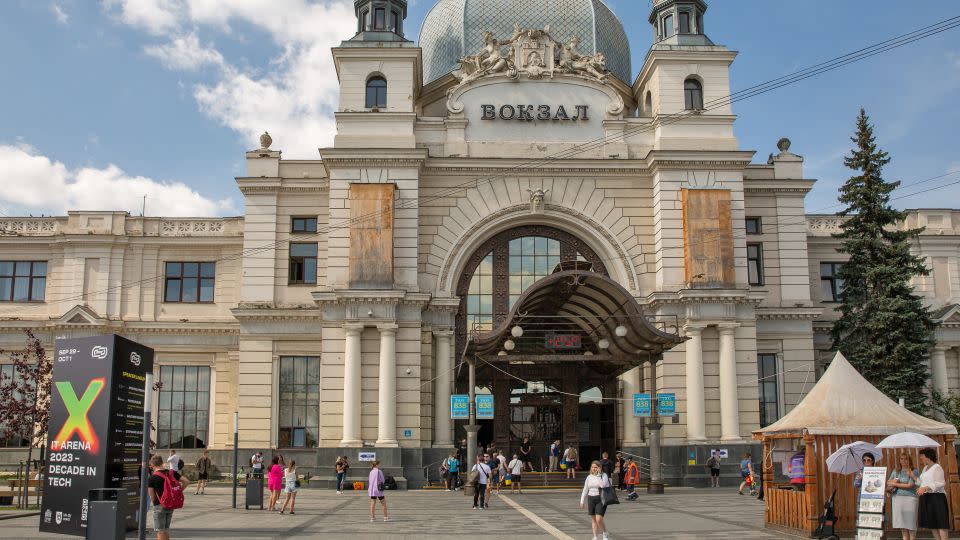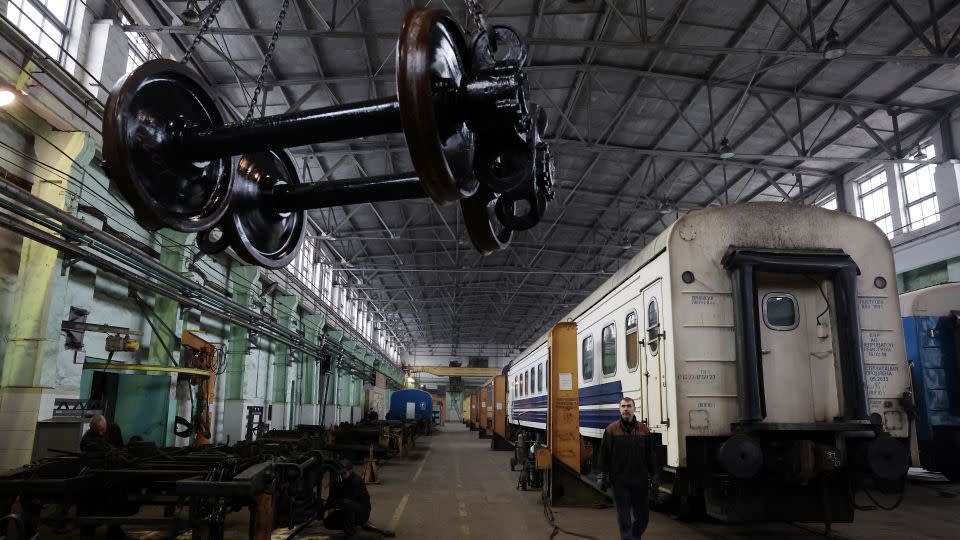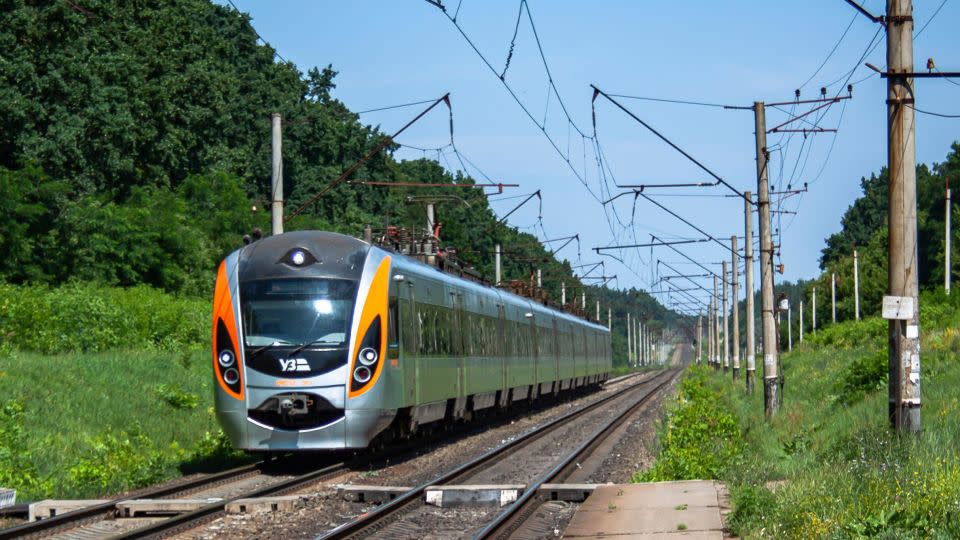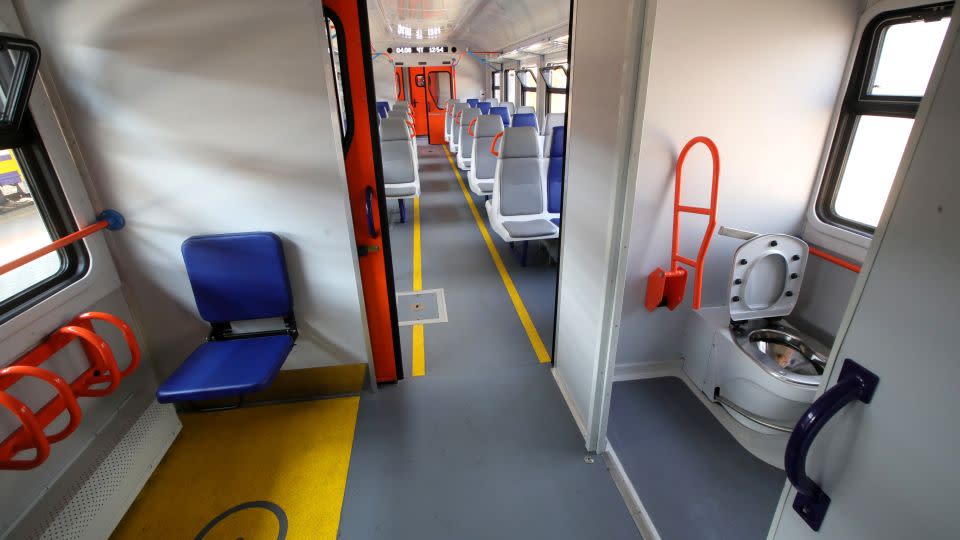Since Russia attacked two years ago, Ukraine has endured ground invasions and relentless missile attacks that have killed thousands and destroyed villages, towns and cities.
Yet, despite all the upheaval, violence and chaos, the trains are still running.
Ukraine’s rail network, known as Ukrzaliznytsia or UZ for short, has always been a source of pride and practicality in the eastern European nation, even before the war. Now, playing a key role in sustaining the war effort, it has gained almost cult status.
With air travel impossible, trains have once again become the primary mode of long-distance travel in the conflict-ravaged country.
Although rail services were disrupted in the early stages of the war, passenger numbers are now back to pre-invasion levels, with 24.9 million passengers carried in 2023. This year, UZ expects that to jump to 27.5 million.
And, even with operations stretched by the evacuation of thousands of civilians and transportation of supplies to the front lines in eastern and southern Ukraine – not to mention the railway employees drafted to fight – UZ has its sights set on bold expansion.
It won’t be easy, however. Keeping the trains running incurs some very human costs.
‘Iron Land’
Visit Kyiv today – for ordinary international travelers, train is currently the best way to make the journey – and the importance of the railway to the people of Ukraine is easily apparent.
Kyiv’s main railway station teems with life as passengers fuss over last-minute shopping or study electronic departure screens listing trains to distant cities such as Odesa and Lviv, or further afield, Warsaw and Vienna.
With 80% of sales now handled online, the station’s old ticket offices have been swept away and replaced by “Iron Land,” a UNICEF-supported space offering a friendly, welcoming space for families on the move.

Here, small kids hustle steam trains around wooden tracks and older siblings play table tennis and discover the science and engineering behind full-size trains.
Designed to provide a moment of calm for families fleeing the violence further east, “Iron Land” aims to show children that railway stations need not be intimidating places, defined by the nightmare of war. It’s part of a nationwide effort by UZ to make its stations into more attractive public spaces.
Similar spaces are now open in Odesa, Lviv and in the station air raid shelter at Kharkiv, close to the Russian border. UZ also plans to rebuild some of its passenger cars with play spaces as it modernizes its fleet.
It’s a stark contrast to the situation further east, where Ukraine’s armed forces appear locked into a war of attrition against Russia, with catastrophic effects for the region’s people, communities and infrastructure. UZ remains vital to defensive efforts – 61,000 people were evacuated by train from front line settlements in 2023, according to the railway company.
Around 18% of Ukrainian territory is currently occupied by Russian forces and much of the railway infrastructure in front line areas has been damaged or is under Russian control.
‘Constant threat’


Despite the danger of aerial attacks, UZ employees continue to risk their lives to move passengers and cargo in areas of eastern Ukraine. This, says Yarema Dul, project manager at UZ’s Strategy and Transformation Department, comes at a cost.
“Long hours, tough conditions and the constant threat of attacks are having a detrimental effect on their physical and mental health,” he says.
“We have a strong responsibility towards our colleagues.”
UZ, says Dul, provides financial, physical and psychological support for injured employees and relatives of those killed in action, through its “Iron Family” program. “We show them that, to us, they are important,” he adds.
To date, around 500 families have received assistance with priority given to those displaced from front line regions, according to UZ.
More than 10,000 UZ employees are currently serving in the armed forces; 573 have been killed and almost 1,500 injured since February 2022, the railway company says.
As well as providing medics and psychological assistance teams for UZ workers suffering as a result of combat operations, the railway company is building a rehab center in Kyiv.
It says it’s also actively planning for a future where it will have to cater for the ever-increasing number of disabled veterans.
Improving accessibility for everyone features heavily in UZ’s modernization plan.
Passenger lifts at major stations, accessible toilets, modified passenger cars with accessible cabins and specially trained attendants and support for deaf passengers are part of a program backed by Ukraine’s First Lady Olena Zelenska.
UZ already has 55 accessible passenger cars on its roster and all new or modernized cars will feature accessibility improvements. More than 10,000 staff have recently received additional training in working with people with disabilities.
Yarema Dul adds: “Accessibility helps everyone, not just the disabled, but we need assistance from our international partners to make contacts, share best practice and acquire new equipment and skills.”
‘Open for business’


Oleksandr Pertsovskyi, head of UZ’s Passenger Division, told CNN Travel: “We’re not just fighting, we’re setting positive goals too. We are open for business and we want people to know that.
“With many Ukrainian families settling in Poland and Germany, for example, they are looking to us to provide reliable, quality transport so that they can visit their homeland and their relatives.
“It’s a sign that the situation is changing; it’s safer and they feel more comfortable about returning home.”
UZ also plays an unusually dominant role in Ukraine’s cargo sector – crucial for keeping Ukraine’s wartime economy alive, as well as supplying war efforts.
According to Yevhen Liaschenko, chairman of the UZ’s management board, rail transport accounts for 65% of the country’s freight traffic – the EU average for rail is just 20% – despite UZ’s cargo division taking a massive hit since February 2022.
“Rail is the most stable form of transport in Ukraine,” Liaschenko tells CNN. “It’s important for us to be a reliable partner for our people, our veterans and the economy.”
Railway of the future


Like the country it serves, UZ is increasingly looking west as it makes plans for the future.
An ambitious $25 billion investment plan includes 3,300 kilometers (2,050 miles) of new standard gauge lines plugged into the EU’s Trans-European Transport Network (Ukraine uses wider 1,520 millimeter tracks inherited from the Soviet Union, which means that trains cannot run through to neighboring countries without changing their wheelsets).
UZ says a further $9 billlon is likely required to repair and modernize the existing UZ network, which at 19,700 kilometers is one of the world’s longest.
Converting the entire network to standard 1,435 millimeter gauge is an impossible dream, but targeted upgrades on key international routes will allow faster and more frequent trains to run from western Ukrainian cities such as Lviv to Warsaw, Budapest, Prague and Berlin, boosting economic ties and creating sustainable inter-city links.
While passengers would undoubtedly benefit, in the long term even bigger gains are likely in the cargo division, where the change of gauge makes importing and exporting by rail difficult, slow and expensive.
Many hoped rail would be Ukraine’s secret weapon in maintaining its status as one of the world’s largest grain exporters after Black Sea ports were blockaded by the Russian navy, but track gauge differences and difficulties in creating priority corridors through Poland and Hungary to EU ports have meant a decline since 2021, UZ figures show.
Yevhen Liaschenko says it plans to implement change quickly, but also wants to think beyond war efforts.
“Normal life goes on and we’re shifting our emphasis from short-term emergency help to long-term improvements and modernization,” he says. “Our responsibility is to be a stable partner.”
Indeed, despite the war, UZ says it has repaired and renewed 289 kilometers of track in 2023, rebuilt 15 bridges, built 528 new freight cars and repaired around 9,000 others.
The international “railway family” is working hard to support its Ukrainian colleagues in their time of need.
Britain’s Network Rail and Swiss Federal Railways are providing engineering support to help rebuild damaged infrastructure, while the Global Ukraine Rail Task Force (GURTF) was established in 2022 to raise funds to support Ukrainian rail workers and their families.
In January, GURTF handed over $135,000 to UZ management and labor union leaders in Kyiv; enough to buy more than 6,000 food packages containing essentials such as cooking oil, rice, pasta and salt. The packages have been distributed to families displaced from front line areas by fighting.
Andy Bagnall, CEO of UK rail lobby group Rail Partners, who joined a delegation visiting Ukraine alongside GURTF representatives earlier this year, says railway workers from around the world wanted to express their solidarity.
“Anything we can do as the railway family to help highlight what they are achieving – in very difficult circumstances – makes a small contribution to something they are living every day,” he says.
Whatever happens on Ukraine’s battlefields in 2024, it seems the country’s railwaymen and women are not just going beyond the call of duty to keep their nation moving, they have their eyes firmly fixed on what comes after this tragic conflict.
For more CNN news and newsletters create an account at CNN.com


